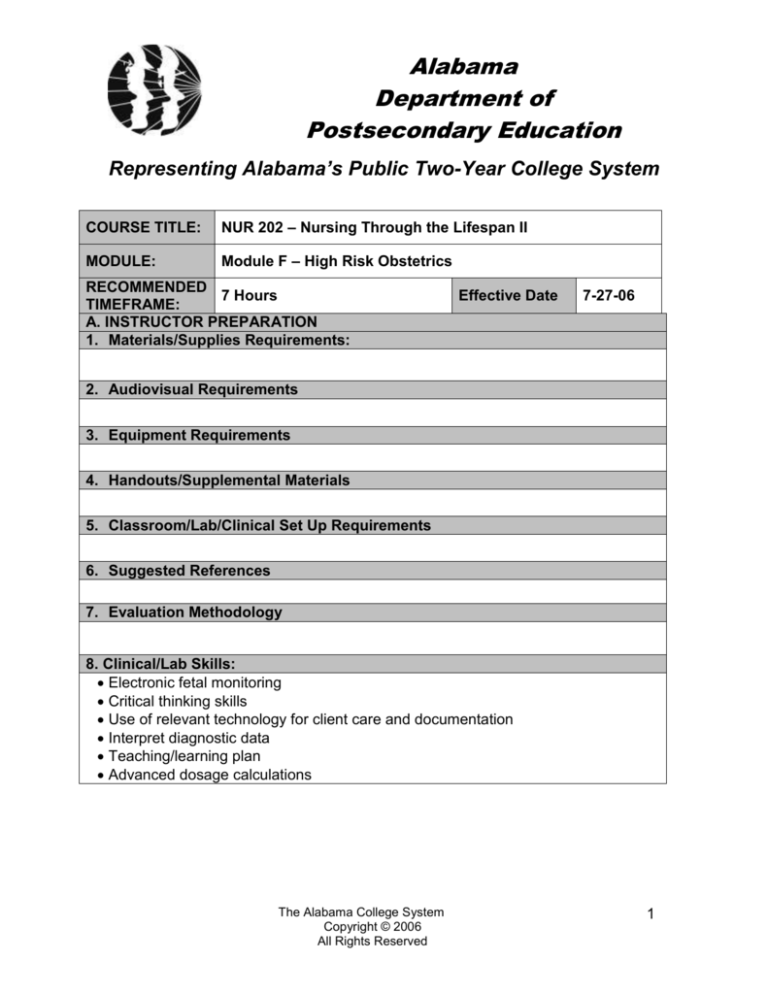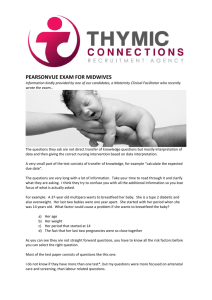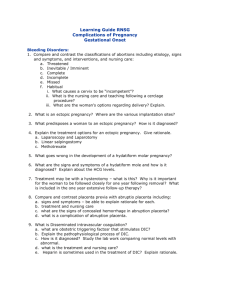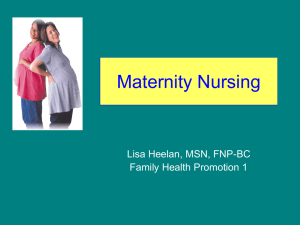
Alabama
Department of
Postsecondary Education
Representing Alabama’s Public Two-Year College System
COURSE TITLE:
NUR 202 – Nursing Through the Lifespan II
MODULE:
Module F – High Risk Obstetrics
RECOMMENDED
7 Hours
TIMEFRAME:
A. INSTRUCTOR PREPARATION
1. Materials/Supplies Requirements:
Effective Date
7-27-06
2. Audiovisual Requirements
3. Equipment Requirements
4. Handouts/Supplemental Materials
5. Classroom/Lab/Clinical Set Up Requirements
6. Suggested References
7. Evaluation Methodology
8. Clinical/Lab Skills:
Electronic fetal monitoring
Critical thinking skills
Use of relevant technology for client care and documentation
Interpret diagnostic data
Teaching/learning plan
Advanced dosage calculations
The Alabama College System
Copyright © 2006
All Rights Reserved
1
Nursing Through the Lifespan II
Module F
NUR 202
B. SUGGESTED PRESENTATION METHODS
1. COMPETENCIES AND OBJECTIVES
COMPETENCY
STUDENT PERFORMANCE OBJECTIVES
F1.0 Provide nursing care for clients
F1.1 Apply the nursing process when caring
experiencing high risk pregnancy.
for clients experiencing high risk
pregnancy.
Instructor Notes:
ACS Copyright © 2006
All Rights Reserved
2
Nursing Through the Lifespan II
Module F
NUR 202
B. SUGGESTED PRESENTATION METHODS
2. LEARNING OBJECTIVES
F1.1.1 Define terms associated with high risk pregnancy.
F1.1.2 Describe complications associated with high risk pregnancy.
F1.1.3 Describe the pathophysiology associated with high risk pregnancy.
F1.1.4 Describe the role of the nurse in providing care for a client experiencing high
risk pregnancy.
F1.1.5 Explain health promotion related to high risk pregnancy.
F1.1.6 Interpret clinical manifestations associated with high risk pregnancy.
F1.1.7 Interpret diagnostic tests for high risk pregnancy.
F1.1.8 Describe the pharmacological agents and/or treatments for high risk
pregnancy.
F1.1.9 Evaluate nutritional considerations for a client experiencing high risk
pregnancy.
F1.1.10 Identify expected outcomes of treatment modalities for a client experiencing
high risk pregnancy.
F1.1.11 Evaluate psychosocial needs of clients, families, and/or support systems.
F1.1.12 Use critical thinking to manage nursing care for a culturally diverse client
experiencing high risk pregnancy.
F1.1.13 Evaluate expected outcomes of nursing care for high risk pregnancy.
F1.1.14 Differentiate between the impact of pregnancy on the adolescent and the
adult client.
Instructor Notes:
ACS Copyright © 2006
All Rights Reserved
3
Nursing Through the Lifespan II
Module F
NUR 202
D. LESSON DEVELOPMENT
Theory = T
Lab = L
Clinicals = C
T
T
L
MAIN POINTS
C
C
T
C
T
C
1.0 Electronic fetal monitoring
1.1 Principles
1.2 Equipment
1.3 Definition of terms
1.4 Internal vs External
1.5 FHR Patterns
1.5.1 Baseline
1.5.1.1 Normal
1.5.1.2 Tachycardia
1.5.1.3 Bradycardia
1.5.2 Variability
1.5.2.1 Periodic Changes
1.5.2.2 Accelerations
1.5.2.3 Decelerations
Early
Variable
Late
1.6 Application of the nursing process
2.0 Induction/augmentation
2.1 Indications/Contraindications
2.2 Determination of readiness
2.3 Methods
2.3.1 Cervical Ripening
2.3.1.1 Mechanical
2.3.1.2 Chemical
2.3.2 Amniotomy
2.3.3 Pharmacological Methods
2.3.3.1 Pitocin/Oxytocin Administration
2.3.3.2 Other
2.4 Application of the nursing process
3.0 Pregnancy induced hypertension (PIH)
3.1 Definition/Classifications
3.2 Incidence and Risk Factors
3.3 Pathology
3.4 Clinical Manifestations
3.5 Diagnostic Testing
3.6 Nutritional Considerations
3.7 Treatments
3.7.1 Home Care vs Hospital Care
3.7.2 Pharmacological Agents
3.8 Application of the nursing process
ACS Copyright © 2006
All Rights Reserved
4
Nursing Through the Lifespan II
Module F
T
C
T
C
T
C
T
NUR 202
4.0 Hemolysis, Elevated Liver Enzymes, Low Platelets (HELLP)
4.1 Definition/Classifications
4.2 Incidence and Risk Factors
4.3 Pathology
4.4 Clinical Manifestations
4.5 Diagnostic Testing
4.6 Treatments
4.6.1 Medical Management
4.6.2 Pharmacological Agents
4.7 Application of the nursing process
5.0 Cardiovascular disease
5.1 Incidence/Classifications
5.2 Pathology
5.3 Clinical Manifestations
5.4 Diagnostic Testing
5.5 Nutritional Considerations
5.6 Treatments
5.6.1 Medical Management
5.6.2 Pharmacological Agents
5.7 Application of the nursing process
6.0 Pre-term labor
6.1 Definition
6.2 Incidence and Risk Factors
6.3 Pathology
6.4 Clinical Manifestations
6.5 Diagnostic Testing
6.6 Prevention/Treatments
6.6.1 Home Care vs Hospital Care
6.6.2 Medical Management
6.6.3 Pharmacological Agents
6.7 Application of the nursing process
7.0 Disseminated Intravascular Coagulation (DIC)
7.1 Definition
7.2 Incidence and Risk Factors
ACS Copyright © 2006
All Rights Reserved
5
Nursing Through the Lifespan II
Module F
NUR 202
E. ASSIGNMENTS AND DUE DATES
F. SUMMARY AND REVIEW
ACS Copyright © 2006
All Rights Reserved
6








